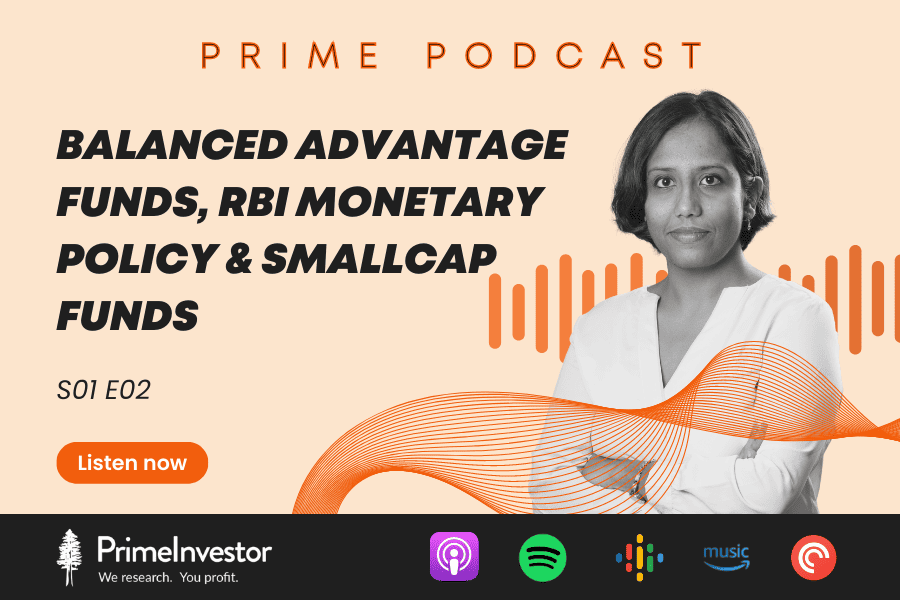What is in this podcast? /Summary
In this episode, we’ll cover key news events and discuss balanced advantage funds and other hybrid funds. Here’s a quick snapshot of the news.
MRF has crossed 1 lakh rupees per share, a remarkable milestone for the Indian markets. The RBI’s recent monetary policy meeting maintained unchanged rates due to concerns about inflation.
The monsoons have arrived with a one-week delay, and while the IMD predicts a normal monsoon, El Nino conditions could potentially affect parts of India later in the season. In the monetary policy, the RBI held on the repo rate, with inflation trends still under watch. Global factors such as geopolitical tensions and the Federal Reserve’s decision to pause rate hikes offer some comfort. For debt fund investments, it’s advisable to stick to your time frame and consider short duration corporate bond or gilt funds. Investing in bank FDs and high-quality bonds during this attractive interest rate period can also be beneficial.
May saw record foreign portfolio investment inflows, indicating confidence from foreign investors. Global giants like Morgan Stanley and Goldman Sachs are optimistic about India’s growth prospects and potential for multibagger stocks. The Nifty and the Nifty Midcap 100/Midcap 150 are reaching new all-time highs, with mid-caps outperforming the Nifty in one-year returns. Small caps are gaining momentum after a significant correction, showing broader market participation. However, be cautious about overloading on small caps if you’re attracted by the high 1-year returns. Remember that while returns can be good, the risk is also higher.
While balanced advantage funds may seem appealing, it’s crucial to understand their behavior. Each fund behaves differently based on how it hedges its equity exposure. Some funds are managed conservatively, while others are more aggressive. These cannot guarantee complete protection from losses, but they will have lower falls compared to pure Equity Funds. However, their long-term returns may be capped due to hedging and debt allocation.
In conclusion, it’s important to be aware of the characteristics of balanced advantage funds and consider your existing portfolio, risk tolerance and investment goals before investing.

Key segments in the podcast discussion
- Introduction and News updates: MRF stock crossing 1 lakh rupees per share, RBI monetary policy, inflation concerns, Monetary Policy and Market Trends (0:00 – 5:35)
- Global and Domestic Factors, Market trends (5:35 – 6:34)
- Discussion on Mid-cap and Small-cap stocks and indices(6:35 – 10:36)
- Overview of Balanced Advantage Funds and how well they manage market risks (10:36 – 17:15)
- Limitations and considerations when investing in hybrid funds (17:16 – 19:10)
- Understanding the Risks and Returns of Balanced Advantage Funds (19:11 – 29:50)
Follow the podcast wherever you listen to podcasts :





8 thoughts on “Podcast : Balanced Advantage Funds, RBI Monetary Policy & Smallcap Funds”
Part of your portfolio to Balanced adv funds or Multi-asset funds is not a bad idea if you have studied them well and understand their model of allocation. The new tax regime on debt funds has created an additional challenge for moving funds from debt to equity and back.
Hi, nice podcast.
Can the hybrid funds like equity savings ,balance advantage and aggressive hybrid find place in different risk buckets of 5 ,10,15 yr duration of a retiree “s retirement plan
Yes, they can as long as you know what the fund does and allocate accordingly…as explained, it’s lower risk equity. – thanks, Bhavana
A quick addition to my previous points . Would it be right to summarize the salient features of BAF as follows?:
1) Debt + and Equity minus [ in terms of fund risk profile ]
2) A counterfoil between Equity and Debt exposure
3) A counter measure for high equity exposure [ even if the current exposure is allocated correctly between large, mid and small cap funds]
4) As a beginners measures to increase / introduce equity exposure , in a “balanced” way
Any or all of these conditions if triggered could make for a use case to introduce BAF into the portfolio?
thanks
1) No idea what you mean 🙂 It is higher risk than debt and lower risk than equity (assuming this is what it is)
2) Yes
3) Yes, but there is still need for debt. Instead of making equity exposure even higher, use these funds.
4) Yes, and especially if the investments are too small to do any proper asset allocation using pure equity and debt. Even aggressive hybrid funds will help here.
Thanks, Bhavana
Got it , thanks ! ( on point 1 , yes that is what I meant 🙂 )
Excellent summary – good going Team PI!! I esp liked the analysis on BAF.
A bit of a mismatch / gap at point @22.55? When discussing about BAF, Bhavana concludes by saying ” if you are low on Debt or you think you have high equity risk , then introduce BAF into the portfolio”. However while I agree and understand on the second part of ” high equity risk” , I thought the basic premise was not to confuse BAF with debt MF? i.e. not a substitute for Debt MF?
The first part of this statement does not appear to sync in with the rest of the hypothesis. Sorry if I am missing something here !
No, balanced advantage funds are not debt substitutes. If you are low on debt, you can add these funds as a means to lower portfolio risk to begin with. But you need add debt funds later. I think it was mentioned somewhere in the initial explanation, but there was a lot said 🙂 – thanks, Bhavana
Comments are closed.